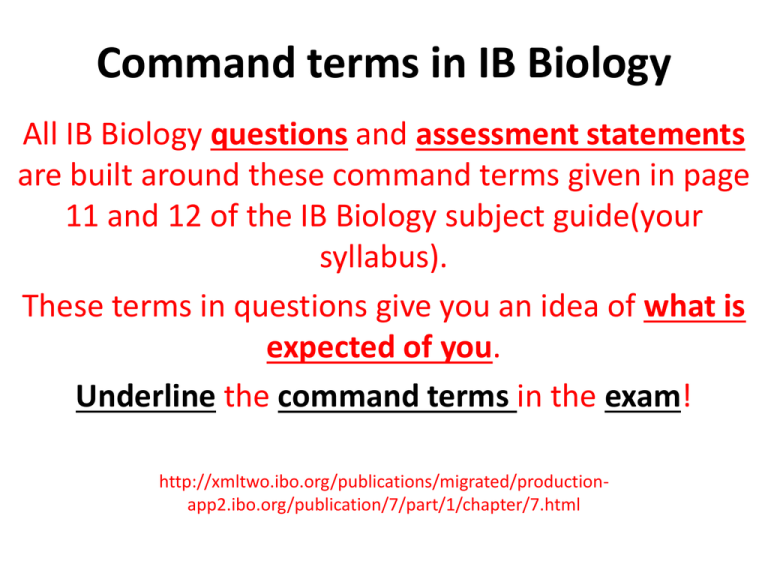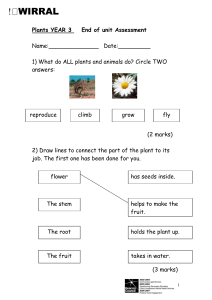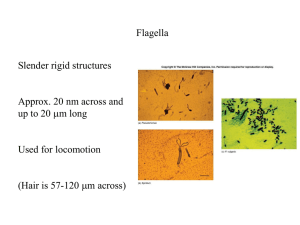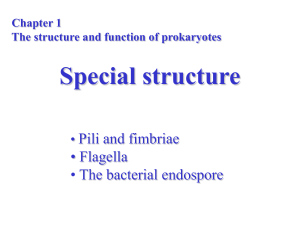Command terms in IB Biology
advertisement

Command terms in IB Biology All IB Biology questions and assessment statements are built around these command terms given in page 11 and 12 of the IB Biology subject guide(your syllabus). These terms in questions give you an idea of what is expected of you. Underline the command terms in the exam! http://xmltwo.ibo.org/publications/migrated/productionapp2.ibo.org/publication/7/part/1/chapter/7.html Objective 1 • • • • • • • Demonstrate an understanding of: Scientific facts and concepts Scientific methods and techniques Scientific terminology Methods of presenting scientific information Define Draw Label List Measure State Define: • Give the precise meaning of a word, phrase or physical quantity • Example: Define Species. • A species is a group of organisms that can interbreed and produce fertile offspring. Draw and Label • Represent by means of clear, dark pencil lines (no coloring needed) and add labels • Example: Draw and label a diagram of the structure of a motor neuron Label • Add labels to a diagram • Example: Label the parts of a motor neuron A D C B H F library.kiwix.org G E List • Give a sequence of names or other brief answers with no explanation • Examples: • List three functions of lipids • List two examples of fibrous proteins • List seven levels in the hierarchy of taxa • (use mnemonics to remember the order here – King Philip Came Over For a Good Sphagetti) Measure • Find a value for a quantity • Use a ruler, present your answers in metric, SI units • Example: Measure the length of the specimen • Generally you will need to calculate from a measurement, rather than measure directly. onearth.org State • Give a specific name, value or other brief answer without explanation or calculation • Example: • State the composition and the function of the plant cell wall. Objective 2 • • • • APPLY AND USE: Scientific facts and concepts Scientific methods and techniques Scientific terminology to communicate effectively appropriate method to present scientific information • Annotate Apply Calculate Describe Distinguish Estimate Identify Outline Annotate Add brief notes to a diagram or graph In addition to labelling, some explanation/causes must be given Example: Annotate a graph showing hormone levels in menstrual cycle Progesterone Maintains endometrium Inhibits FSH and LH FSH and LH peak causing ovulation Oestrogen thickens endometrium FSH and LH stimulate development of oocyte Pritamaulipas.org.mx Apply • Use an idea, equation, principle, theory or law in a new situation • Example: Apply the dichotomous key to identify the flowering plant: • 1.reproduce by means of seeds Reproduce by means of spores • 2. Seeds are made in cones Seeds are made in fruits • 3.Spores are made in capsule Spores are made under leaves go to 2 go to 3 A B C D Calculate • Find a numerical answer showing the relevant stages in the working • Example: Calculate the magnification of the image of the prokaryote Show your working! Use the correct SI unit! Describe Give a detailed account Example: Describe the metabolic events of germination in a typical starchy seed. •‘Describe’ is not same as ‘explain’ •Pay attention to the marks available for the question •Descriptions can be of processes or of parts of a data or graph Distinguish • Give the differences between two or more different terms • Example: • Distinguish between antigens and antibodies • No need to present similarities • Look for as many differences as there are marks for the questions Estimate • Find an appropriate value for an unknown quantity • Can be from graphical questions Identify • Find an answer from a given number of possibilities “Identify the response time of group 2 on day 31 of the study.” “Identify the group with the largest difference in response time from day 2 to day 31.” Response time (secs) Example: May2009TZ1SLP3 Pick one single answer ‘Identify’ can be used for part of diagram or graph Outline • Give a brief account or summary • Example: . Outline the international system used for naming species of living organisms. (4 marks) • binomial system • devised by Linnaeus • the first name is the genus name and the second name is the species name • genus name can be abbreviated, upper case for first letter of genus name and the rest of the binomial is lower case • Homo sapiens is the binomial of humans • first published name is the correct one • local / colloquial names can be very confusing / helps international communication • • Outline is a step-by-step summary or account without reasons or explanation Present your answers neatly and clearly to get full marks Objective 3 • Construct, analyse and evaluate: • Hypotheses, research questions and predictions • Scientific methods and techniques • Scientific explanations Analyse Interpret data to reach conclusions Example: “Analyse the results of this experiment.” QuestionBank CD Rom Read the data thoroughly and underline the important words Use the data to reach the conclusion Pay attention to marks available Comment • Give a judgment based on a given statement or result of a calculation Compare • Give an account of similarities and differences between two or more items referring to both (all) of them throughout. Example: Compare the structures of prokaryotic and eukaryotic cells. 5 marks • DNA: P: naked/loop of DNA; E: associated with protein/histones/nucleosomes/DNA in chromosomes • location of DNA: P:no nucleus; E: within a nucleus/nuclear membrane • membrane bound organelles: P: none; E: present • ribosomes: P: 70S ; E: 80S • plasma membrane: P & E: same structure within both groups • respiratory structures: P: no mitochondria; E: mitochondria • pili: P: pili present E: pili absent; • plasmids: P: plasmids (sometimes) present E:plasmids absent; • flagella: P: flagella solid E: flagella flexible/membrane-bound CONSTRUCT • Represent or develop in graphical form • Construct a pyramid of energy for this grassland: The total solar energy received by a grassland is 4 × l05 kJ m–2 y–1. The net production of the grassland is 4.5 × 102 kJ m–2 y–1 and its gross production is 5 × l02 kJ m–2 y–1. The total energy passed on to primary consumers is 50 kJ m–2 y–1. Only 10 % of this energy is passed on to the secondary consumers.” Deduce • Reach a conclusion from the information given • Example: Deduce the trophic level of Tuna in the given food web Shark Marlin Plankton Tuna Shrimp Herring Derive • Manipulate a mathematical relationship to give a new equation or relationship Design • Produce a plan, simulation or model Determine • Find the only possible answer • In a species of plant, tall is dominant to short and the production of round seeds is dominant to that of wrinkled seeds. The alleles are unlinked. • A plant heterozygous for both characteristics is crossed with a plant homozygous for tall with wrinkled seeds. • Determine the phenotypes and genotypes of the offspring of this cross. Discuss • Give an account including, where possible, a range of arguments for and against the relative importance of various factors, or comparisons of alternative hypotheses • Example: Discuss the ethical implications of IVF • chance for infertile couples to have children; • genetic screening of embryos could decrease suffering from genetic diseases; • spare embryos can safely be stored for future pregnancies/used for stem cell research; • IVF is expensive and might not be equally accessible; • success rate is low therefore it is stressful for the couple; • it is not natural/cultural/religious objections; • could lead to eugenics/gender choice; • could lead to (unwanted) multiple pregnancies with associated risks. Evaluate • Assess the implications and limitations Example: “Evaluate the evidence for global warming, using figures A and B (2).” Biology Specimen Paper, 2009 Do not just describe, use evaluative language. Think of the reliability and limitations the given data have to arrive at a conclusion. Explain • Give a detailed account of the causes, reasons or mechanisms • Using an example you have studied, explain a cross between two linked genes, including the way in which recombinants are produced. Predict • Give an expected result • A farmer has rabbits with two particular traits, each controlled by a separate gene. Coat colour brown is completely dominant to white. Tailed is completely dominant to tail-less. A brown, tailed male rabbit that is heterozygous at both loci is crossed with a white, tail-less female rabbit. A large number of offspring is produced with only two phenotypes: brown and tailed, white and tail-less, and the two types are in equal numbers. • Predict the genotypic and phenotypic ratios of the F2 generation. Show your working. Show • Give the steps in a calculation or derivation Example: “A male and female with normal colour vision each have a father who is colour blind. They are planning to have children. Predict, showing your working, the possible phenotypes and genotypes of male and female children.” Always show your working in ‘calculate’ and ‘determine’ questions! QuestionBank CD Rom Sketch • Represent by means of a graph showing a line and labelled but unscaled axes with important features clearly indicated. Example: “Sketch a graph to predict the effect of manipulating pH on the activity of an enzyme which has an optimal pH of 7.” Optimum pH Enzyme activity denatured 6 7 8 pH Suggest • Propose a hypothesis or other possible answer Example: “Suggest one reason in each case for the change in quantity of fish captured in the Atlantic and Indian Oceans from 1980 to 1990.” QuestionBank CD Rom










